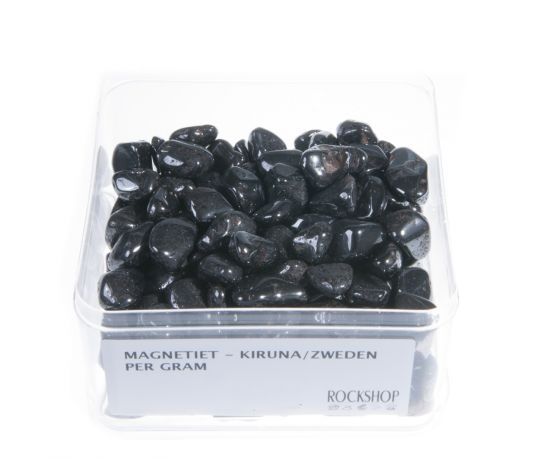We use cookies to make your experience better.
Magnetite from the mines in Kiruna Sweden.
- Buy 100 for €0.15 each and save 21%
- Buy 1000 for €0.12 each and save 37%
The mineral magnetite is an oxide of iron 2+ and 3+ with valences. The chemical formula is Fe 3+ 2Fe2 + O4. Magnetite is a gray black strong natural magnetic mineral with no cleavage with an average density of 5.15. The hardness is 5.5 to 6. The mineral is not radioactive. The refractive index is 2.42, and the cubic mineral is isotropic. With striking light gray with brown reflections can be observed. In Antiquity discovered that magnetite crystals attract each other depending on the orientation or repel. This physical phenomenon is called magnetism. In China it was already in the 11th c. BC. use of the magnetic properties of magnetite. The terms 'magnet', like medieval term for a magnetic stone, and imported by Wilhelm Haidinger in 1845 'magnetite', originated from the Latin root "magnetoplumbite (with the nominative 'magnes' magnet). Magnetic stones (Ancient Greek: λίθος μάγνης, lithos Magnes) were already known to the Greeks, according to the writings of Theophrastus. The Roman writer Pliny the Elder mentions a stone called 'magnet', which would be called to Magnes, a Cretan shepherd that mineral on Mount Ida found. He noted that the nails in his shoes and the iron head of his staff through the rock where the mineral was attracted to. Pliny made a distinction between various types of magnets, especially between "male" and "female". Only the male had the power to attract iron, so it was real magnetite. In female magnets it was presumably for manganese ore, which seems to look a lot like magnetite, or even a white mineral that later magnesite MgCO3 was called. However, it is likely that magnetite is named after Magnesia, a region in Thessaly or to the city of Magnesia on the Meander, or even to other Greek or Asia Minor city of the same name, where more than 2500 years of magnetic chunks of iron ore are found.
Powermagnets












